
table of contents
- Popular with bees
- Types from A - G
- Types of H - J
- Types with K
- Types from L - N
- Types of O - R
- Types with S
- Types from T - Z
- frequently asked Questions
Willows belong to the group of deciduous trees. They can grow up to 30 meters tall as a tree, but also grow as shrubs. There are over 450 different types. To distinguish them is not so easy.
In a nutshell
- popular source of food for bees & co
- grow as trees and bushes
- Flowering period from March to June
- the flowers are called catkins
- do not make any special demands on the location
Popular with bees
All types of willow are a very popular source of food for bees & Co. Their flowers appear between March and June. These are known as kittens. Almost all types of willow are dioecious, with the exception of the weeping willow. A willow (Salix) has either only female flowers or only male flowers. They are pollinated by bees. The plants do not make any special demands on the location. The only thing worth mentioning is their high water requirement. Willow trees can get very old. Eighty years are not uncommon.
Types from A - G
Ash willow (Salix cinerea)
Gray willow

- Height: up to 5 m
- Growth: bushy, upright
- Leaves: elliptical to obovate, serrated edge, kidney-shaped stipules, gray-green
- Branches: gray-green to reddish, dense, creeping lower ones
- Flowering period: March to April
- Flowers: yellow, egg-shaped, upright, with a sweet smell
Pale Willow (Salix starkeana)
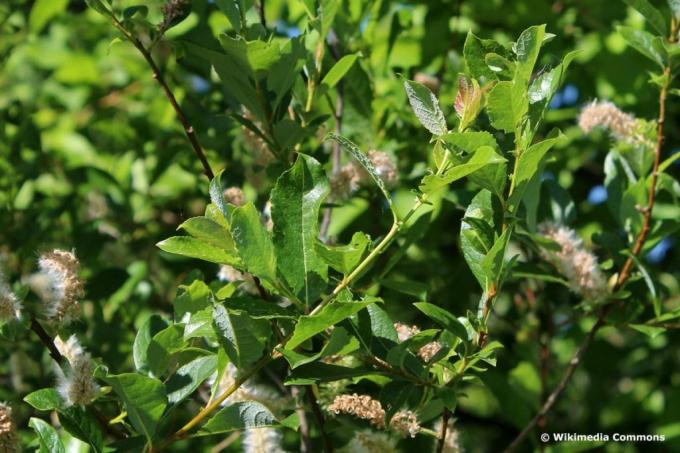
- Height: 1 m
- Habit: shrubby, prostrate to arching and ascending
- Leaves: lanceolate to ovoid, semi-kidney-shaped stipules, serrated edge, glossy olive-green upper side, blue-green underneath
- Branches: thin, glabrous, red-brown to purple-red
- Flowering period: March to April
- Flowers: pendulous, elliptical, yellow-green
Engadin willow (Salix hastata "Wehrhahnii")
Spit willow

- Height: 125 cm
- Growth: bushy, stocky
- Leaves: ovoid, dark green upper surface, greyish lower surface
- Branches: red-brown, arching upwards
- Flowering period: April to early May
- Flowers: elongated, yellow, fragrant
Types of H - J
Harlequin Willow (Salix integra "Hakuro Nishiki")
Japanese ornamental willow; White willow

- Height: 3 m
- Habit: shrub, spherical
- Leaves: elliptical to elongated, smooth-edged, variegated pink-white
- Branches: glabrous, reddish in color, yellow-brownish buds
- Flowering period: March to April
- Flowers: yellow, inconspicuous catkins, elongated
Note: The color of the leaves is always dependent on the intensity of the light. It only comes in the sun splendid foliage color really come into its own.
Japanese dragon willow (Salix sachalinensis "Sekka")
- Height: 3 to 5 m
- Growth: bizarre, expansive
- Leaves: lanceolate, narrow, pointed, glossy green upper surface, bluish lower surface
- Twigs: curved, red-brown
- Flowering period: March to April
- Flowers: up to 5 cm long, yellowish-white
Types with K
Bare willow (Salix glabra)
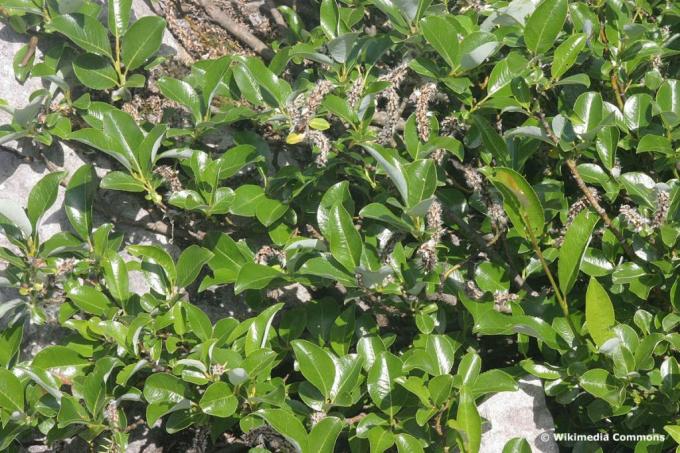
- Growth height: up to 150 cm
- Growth: bushy, dense
- Leaves: elliptical - ovate, serrated edge, glossy green upper surface, white lower surface with a thick wax coating
- Branches: thick, glabrous, red-brown
- Flowering period: May to June
- Flowers: elliptical, yellow
Crack willow (Salix fragilis)
Broken willow

- Height: up to 20 m
- Habit: tree, arched crown
- Bark: smooth white-gray to black-gray
- Leaves: lanceolate, finely sawn edge, glossy light green upper surface, pale gray lower surface
- Branches: green, thin, flexible, yellow-red buds
- Flowering period: March to April
- Flowers: elongated, gray-white
Osier (Salix viminalis)
Hemp willow

- Height: 8 m
- Growth: often with multiple stems
- Bark: gray to gray-black, cracked
- Leaves: narrow, lanceolate, finely sawn edge, dark green upper side, hairy silver-gray underside
- Branches: thin, flexible, greenish, reddish buds
- Flowering period: April to May
- Flowers: cylindrical, gray-white
- Special feature: long rods suitable for making baskets
Corkscrew willow (Salix matsudana "Tortuosa")
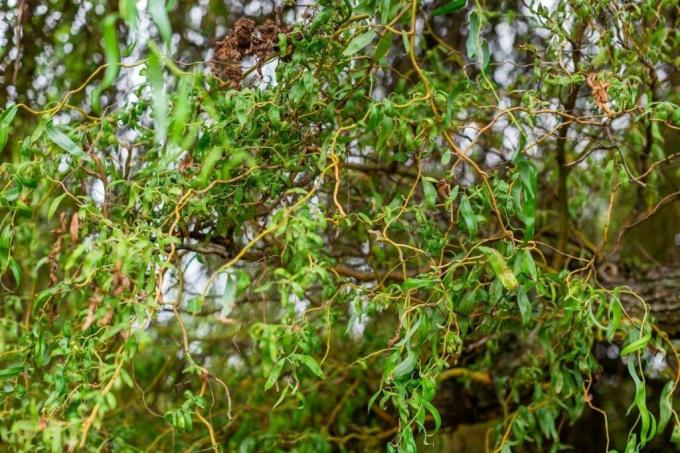
- Height: 4 to 12 m
- Growth: upright, bizarre, as a tree or shrub
- Bark: longitudinally fissured, gray-brown
- Leaves: narrow, lanceolate, twisted like a corkscrew, green upper side, bluish-white lower side
- Branches: spirally wound, yellow-green
- Flowering period: March to April
- Flowers: elongated, gray-white
- Special feature: good solitary plant, popular vase jewelry
Cabbage willow (Salix herbacea)
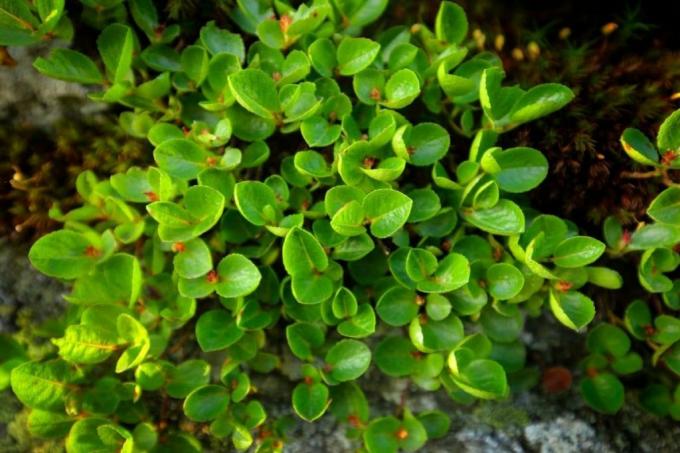
- Height: 2 to 10 cm
- Habit: creeping dwarf shrub, woody trunk
- Leaves: round, glabrous, slightly toothed, short stalked, shiny light green
- Branches: thin, brownish to black, prostrate, also creeping underground
- Flowering period: May to September
- Flowers: terminal, spherical catkins with 4 to 12 flowers, bright red anthers
- Special feature: Use in the rock garden, alpinium, bucket
Types from L - N
Curly willow (Salix erythroflexuosa)
- Height: 3 to 5 m
- Growth: slender, initially upright, later arching overhanging
- Leaves: long, narrow, dark green upper side, blue-green lower side
- Branches: twisted in a spiral, yellow-green when young, reddish in winter
- Flowering period: February to April
- Flowers: initially silvery fluffy, later yellow
Laurel willow (Salix pentandra)
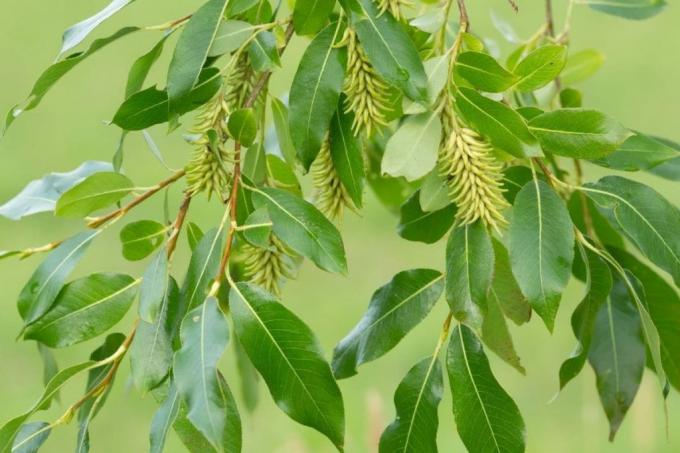
- Height: up to 15 m
- Growth: multi-stemmed
- Bark: dark gray, cracked
- Leaves: lanceolate, pointed, serrate, dark green glossy upper side, bluish-gray lower side, bitter almond scent
- Branches: flexible, glabrous, shiny red-brown, light balsamic scent
- Flowering period: June to July
- Flowers: cylindrical, large, yellow-white, smelling of honey
Almond Willow (Salix triandra)

- Height: 10 m
- Habit: large shrub, sometimes a small tree
- Leaves: lanceolate, serrated, upper side matt dark green, lower side bluish-green, green-red shoots
- Branches: shiny brown-gray when young, later scaly with an orange-brown pattern
- Flowering period: April to May
- Flowers: slender, yellow
Reticulated willow (Salix reticulata)

- Height: 10 to 25 cm
- Habit: prostrate, broad-growing, spiral shrub
- Leaves: elliptical to circular, curved edge, woolly hairs, surface glossy dark green, underside white-gray
- Branches: rooting, yellow-green to olive-green
- Flowering period: June to August
- Flowers: erect, reddish-yellow
Types of O - R
Ear willow (Salix aurita)

- Height: up to 3 m
- Habit: shrub, upright, bushy, many runners
- Leaves: obovate, bluntly toothed, two heart-shaped stipules (auricles), green
- Branches: thin, arched, ascending, gray to red-brown
- Flowering period: April to May
- Flowers: oval catkins, yellow, slightly fragrant
Purple willow (Salix purpurea)

- Height: 2 to 6 m
- Habit: upright, densely bushy, shrub
- Leaves: lanceolate, pointed, smooth-edged, blue-green upper side, greyish lower side
- Branches: thin, long, shiny purple-red
- Flowering period: March to April
- Flowers: curved, slender, initially red, later yellow
Note: The bark and leaves are used for diseases such as rheumatism, fever, flu or intestinal diseases.
Ripe willow (Salix daphnoides)

- Height: up to 15 m
- Growth: tree
- Bark: gray, slightly longitudinally fissured
- Leaves: lanceolate, tapering to a point, finely sawn edge, glossy dark green upper surface, matt blue-green lower surface
- Branches: initially shiny red, later bluish-white
- Flowering period: March to April
- Flowers: cylindrical, yellow
Rosemary willow (Salix rosmarinifolia)
Rosemary-leaved willow

- Height: up to 2 m
- Habit: shrub, bushy, prostrate trunks
- Leaves: lanceolate to linear, with entire margins, top dark green, underside silvery silky hairy
- Twigs: ascending, shoots tomentose, red-brown
- Flowering time: April
- Flowers: spherical to ovoid, green to yellow
Types with S
Common willow (Salix caprea)

- Height of growth: tree up to 10 m, shrub 3 to 5 m
- Habit: compact shrubs, moderately branched trees
- Leaves: ovate, serrated edge, upper side dark green, lower side silvery, sunken leaf veins
- Branches: thin, flexible, greenish
- Flowering period: March to April
- Flowers: gray-white, slightly fragrant
Note: The flowers are called pussy willow or Catkins known. They are mainly used in Easter arrangements.
Swiss willow (Salix helvetica)

- Height: 60 to 100 cm
- Habit: small shrub, upright, bushy, spherical
- Leaves: oblong, lanceolate to obovate, green on top, silver-gray on the underside
- Branches: thick with a thick layer of white felt, later dark brown, growing arched on the ground
- Flowering time: April
- Flowers: upright, initially yellow, later silver-gray
Blunt-leaved willow (Salix retusa)
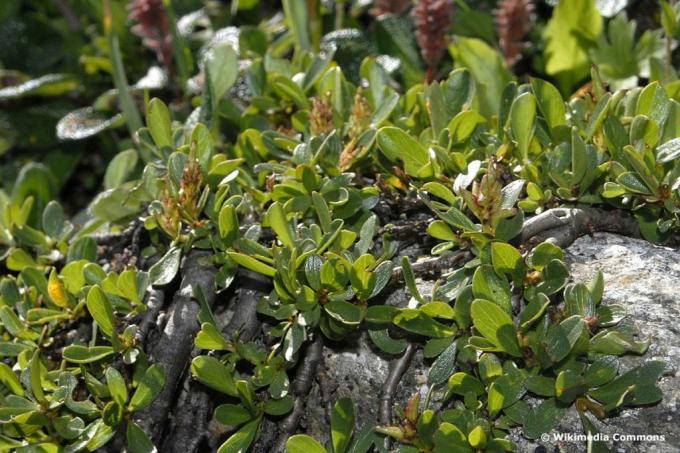
- Growth height: up to 20 cm
- Habit: low-lying spiral shrub
- Leaves: obovate, smooth-edged, glabrous, shiny green
- Branches: rooting on the ground, short, olive green to brown
- Flowering period: June to July
- Flowers: catkin-shaped inflorescence with ten or more flowers, upright, yellow
Types from T - Z
Weeping Willow (Salix babylonica)
Hanging willow

- Height: up to 20 m
- Habit: tree, quite expansive
- Bark: gray-brown
- Leaves: elongated, tapering to a point, serrated edge, shiny green
- Branches: drooping, thin, elastic, glabrous, yellow
- Flowering period: April to May
- Flowers: slender, cylindrical, drooping, fragrant, yellow
Woolly willow (Salix lanata)

- Height: 75 to 150 cm
- Growth: sparse, bushy
- Leaves: roundish ovate to obovate, wavy edge, upper surface matt green, lower surface bluish-green
- Twigs: thick, brownish, woolly white hairy buds
- Flowering period: March to April
- Flowers: long, elliptical, golden yellow, slightly fragrant
Note: The woolly willow is often planted in heather gardens and used as a hedge plant.
frequently asked Questions
No. All parts of the pasture are non-toxic. Young leaves are even edible. They can be used in salads. The rind tastes a bit bitter, but can be used to brew tea. The ingredients contained in the willow, such as salicin, are basic substances in the manufacture of medicines.
In principle, they are relatively easy to care for. Young plants need to be watered regularly. Even with older specimens, the soil should not dry out completely. Alternatively, a layer of mulch can be applied to the root disc. This limits the evaporation of water. Compost should be added in spring, alternatively long-term fertilizer.
Yes absolutely. Regular pruning should be carried out, as willows are usually fast-growing. Pruning measures should be made in spring. The plants are quite easy on pruning, they don't mind a radical pruning either.



